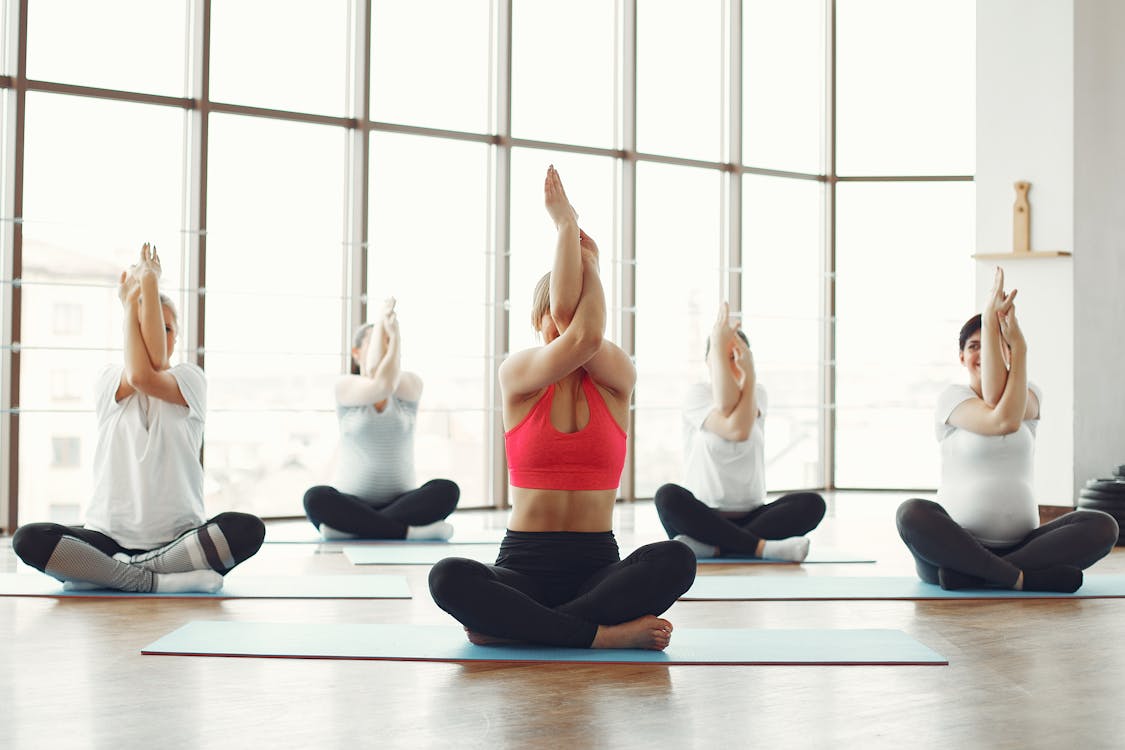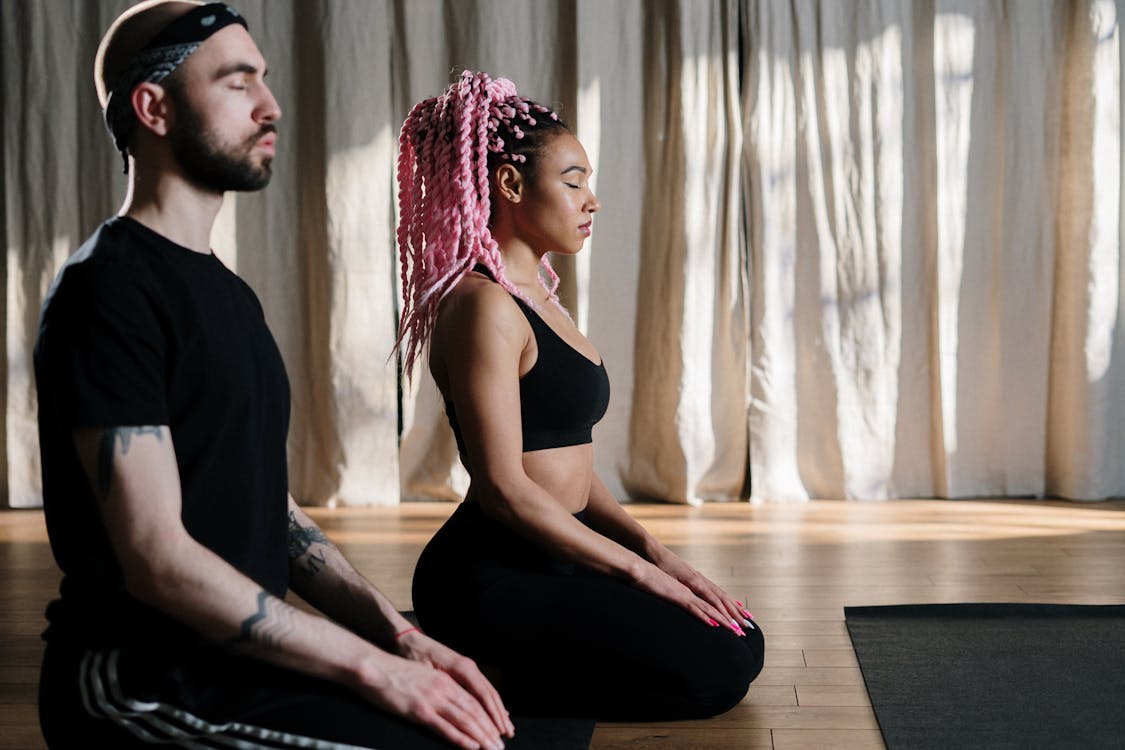
Yoga is a physical, mental, and spiritual practice that originated in ancient India. In recent years, it has gained immense popularity all around the world as people have started realizing the numerous benefits it has to offer. Yoga is not just a form of exercise; it is a way of life that can help you find balance and inner peace.
I. Introduction

A. Brief Explanation of Yoga and Its Principles
Yoga is an ancient practice that originated in India thousands of years ago. It encompasses a holistic approach to achieving harmony and balance in the mind, body, and spirit. The word “yoga” is derived from the Sanskrit root “yuj,” which means to unite or join, symbolizing the union of individual consciousness with universal consciousness. The practice of yoga involves various physical postures (asanas), breathing exercises (pranayama), meditation (dhyana), and ethical principles (yamas and niyamas).
At its core, yoga aims to cultivate self-awareness, inner peace, and spiritual growth. It emphasizes the importance of living in the present moment and connecting with one’s inner self, leading to a deeper understanding of one’s thoughts, emotions, and actions. The principles of yoga extend beyond the mat and into daily life, promoting a mindful and compassionate way of living.
B. Definition of Fitness and Its Importance
Fitness, on the other hand, refers to the state of being physically and mentally capable of performing daily activities effectively and efficiently. It encompasses several components, including cardiovascular endurance, muscular strength and endurance, flexibility, and body composition. Achieving and maintaining fitness is crucial for overall health and well-being.
Regular physical activity and exercise are essential for preventing chronic diseases such as obesity, diabetes, and heart disease. Exercise also plays a significant role in improving mental health, reducing stress and anxiety, enhancing cognitive function, and boosting mood and self-esteem. Moreover, fitness contributes to better quality of life, increased energy levels, and improved sleep patterns.
C. Thesis Statement: Exploring How the Combination of Yoga and Fitness Can Lead to Optimal Health
The combination of yoga and fitness holds the potential to unlock a pathway to optimal health that addresses not only the physical aspects of well-being but also the mental and emotional dimensions. Integrating the principles of yoga with traditional fitness exercises can create a synergistic effect that enhances the benefits of both practices. This article will delve into the various ways in which yoga complements fitness and vice versa, leading to a holistic and transformative approach to health and wellness.
By examining the physical benefits of yoga, such as improved flexibility, strength, and balance, we will understand how these aspects can enhance overall fitness performance. Additionally, the impact of yoga on mental well-being, stress reduction, and mindfulness will be explored, highlighting how a positive mindset can elevate motivation and commitment to regular fitness practice.
Furthermore, this article will delve into how yoga and traditional fitness can be integrated to create a well-rounded workout routine that targets different aspects of physical fitness. Whether it’s combining yoga with cardiovascular exercises to improve heart health or integrating strength training with yoga to achieve a balanced and comprehensive approach, we will explore the synergy between the two practices.
II. The Benefits of Yoga for Physical Fitness

A. Description of Yoga Asanas and Their Impact on Flexibility, Strength, and Balance
Yoga asanas, or postures, form the foundation of a yoga practice and offer a diverse range of physical benefits. Through regular practice, individuals can experience a significant improvement in flexibility, as yoga postures involve stretching and lengthening various muscle groups. Poses like Downward Dog, Forward Fold, and Cobra gently elongate the muscles, promoting increased range of motion in the joints and reducing the risk of injuries in everyday activities and other physical exercises.
Furthermore, yoga postures are designed to engage and strengthen different muscle groups. Asanas such as Warrior Poses, Plank, and Chair Pose target the core, legs, and upper body, respectively, building muscular strength and endurance. The integration of bodyweight resistance in yoga helps tone and define muscles, leading to a more balanced and functional physique.
B. How Yoga Complements Traditional Fitness Exercises and Improves Performance
One of the distinctive advantages of yoga is its ability to complement and enhance traditional fitness exercises. While many workouts focus on repetitive movements and high-impact activities, yoga introduces a mindful and low-impact approach to fitness. By incorporating yoga into a fitness regimen, individuals can prevent overuse injuries and create a more balanced workout routine.
For instance, yoga’s emphasis on core strength and stability can significantly benefit exercises like weightlifting, running, or cycling, as a strong core provides a solid foundation for other movements. Additionally, improved flexibility from yoga can lead to better form and technique in weightlifting and reduce the risk of strains and sprains during dynamic movements.
Moreover, yoga’s focus on breath control and mindfulness can positively impact endurance-based activities. By learning to control their breath and stay present in the moment, individuals can maintain a steady pace and conserve energy during cardiovascular workouts, leading to improved performance and reduced fatigue.
C. Case Studies or Scientific Studies Demonstrating the Physical Benefits of Yoga
Scientific research supports the numerous physical benefits of yoga. Several studies have shown that regular yoga practice can lead to increased flexibility, strength, and balance. One study published in the International Journal of Yoga demonstrated that participants who practiced yoga for six weeks experienced significant improvements in flexibility and balance compared to a control group.
Furthermore, a review published in the Journal of Bodywork and Movement Therapies concluded that yoga can effectively improve muscular strength and endurance, especially in the core and upper body muscles. The study also noted that yoga’s low-impact nature makes it suitable for individuals of various fitness levels, including beginners and those with physical limitations.
In addition to these findings, case studies have showcased how incorporating yoga into an athlete’s training routine has positively impacted their performance and recovery. For example, a professional runner who integrated yoga into her training reported reduced muscle soreness and improved running form, which translated to faster race times and fewer injuries.
III. Yoga for Mental Well-being and Motivation in Fitness

A. The Role of Mindfulness and Meditation in Reducing Stress and Anxiety
Yoga’s emphasis on mindfulness and meditation plays a vital role in promoting mental well-being. During yoga practice, individuals are encouraged to be fully present in the moment, focusing on their breath and bodily sensations. This mindfulness practice allows them to let go of distractions and worries, creating a space for relaxation and stress reduction.
Scientific studies have demonstrated the effectiveness of yoga in reducing stress and anxiety. Research published in the Journal of Clinical Psychology showed that participants who engaged in a yoga program experienced significant reductions in perceived stress levels and reported improved emotional regulation. The practice of mindfulness meditation in yoga has been linked to changes in brain activity, including decreased activity in the amygdala, the brain’s fear center, leading to reduced feelings of anxiety.
Moreover, yoga’s deep-breathing techniques, such as pranayama, activate the body’s parasympathetic nervous system, which triggers the relaxation response. This response counteracts the fight-or-flight response triggered by stress, promoting a sense of calmness and tranquility. By incorporating mindfulness and meditation through yoga, individuals can better manage stress and anxiety, which can have a profound impact on their overall mental well-being and resilience in the face of life’s challenges.
B. How a Positive Mindset through Yoga Enhances Motivation for Regular Fitness Practice
Yoga fosters a positive mindset by cultivating self-compassion, self-acceptance, and a non-judgmental attitude toward oneself and others. During yoga practice, individuals are encouraged to embrace their bodies and minds as they are, without comparison or criticism. This self-affirming approach fosters a sense of self-confidence and appreciation for one’s abilities, creating a foundation of motivation for pursuing fitness goals.
Through yoga, individuals learn to focus on the process rather than the outcome, embracing the journey of self-improvement and growth. This mindset shift helps individuals stay committed to their fitness routine, even when facing challenges or setbacks. Yoga practitioners often develop a deeper sense of determination and discipline, recognizing that progress may not always be linear, but consistent effort leads to positive changes over time.
Furthermore, yoga teaches individuals to be patient with themselves and practice self-care, recognizing the importance of rest and recovery in achieving optimal fitness. By understanding the value of balance and self-compassion, individuals are less likely to engage in overly strenuous workouts or push themselves beyond their limits, reducing the risk of burnout or injury.
C. Real-life Examples of Individuals Finding Mental Clarity and Focus Through Yoga
Real-life testimonials provide compelling evidence of the transformative impact of yoga on mental clarity and focus. For example, Sarah, a busy professional, struggled with work-related stress and anxiety. Upon incorporating yoga into her daily routine, she noticed a significant improvement in her ability to stay present and focused during high-pressure situations. The regular practice of meditation allowed her to approach challenges with a calm and composed mindset, enhancing her productivity and overall job satisfaction.
Another example is Mark, an avid fitness enthusiast who initially approached workouts with a competitive and goal-oriented mindset. Through practicing yoga, he learned to listen to his body and respect its limitations, leading to reduced feelings of frustration and disappointment. This newfound sense of self-awareness and mindfulness not only improved his fitness performance but also elevated his overall outlook on life.
These examples illustrate how yoga can empower individuals to achieve mental clarity, emotional stability, and a deeper sense of purpose in their fitness journeys. By cultivating a positive mindset and embracing mindfulness, individuals can uncover the hidden potential within themselves, not only in the physical realm but also in their mental and emotional well-being.
IV. Integrating Yoga and Fitness in a Routine

A. Practical Tips for Incorporating Yoga into a Fitness Regimen
Integrating yoga into a fitness routine requires thoughtful planning and commitment. Here are some practical tips to seamlessly incorporate yoga into your daily schedule:
- Start with Short Sessions: If you are new to yoga, begin with short sessions to gradually build your practice. Even 10 to 15 minutes of yoga in the morning or before bedtime can make a difference in your physical and mental well-being.
- Mix and Match: Blend yoga with your favorite fitness activities. For example, after a challenging strength training session, follow up with gentle yoga stretches to relax the muscles and enhance flexibility.
- Use Online Resources: With the abundance of online yoga classes and tutorials, you can find sessions that suit your fitness level and preferences. Utilize apps or websites that offer guided yoga practices to stay motivated and inspired.
- Be Consistent: Aim for regularity in your yoga practice. Whether it’s three times a week or every day, consistency helps you build strength, flexibility, and mindfulness over time.
- Create a Sacred Space: Designate a quiet and clutter-free area for your yoga practice. Having a dedicated space can enhance focus and provide a sense of tranquility during your sessions.
- Listen to Your Body: Pay attention to how your body responds to yoga and fitness exercises. If you feel fatigued or sore, consider choosing a restorative yoga practice or allowing yourself a day of active rest.
B. Creating Balanced Workout Schedules that Include Both Yoga and Traditional Exercises
Achieving a well-balanced workout schedule is essential for overall fitness and longevity. Here’s how you can create a comprehensive routine that incorporates both yoga and traditional exercises:
- Assess Your Fitness Goals: Determine your fitness objectives, such as strength building, cardiovascular endurance, or flexibility improvement. This assessment will help you identify which yoga styles and traditional exercises best align with your goals.
- Divide Your Week: Split your workout schedule into different focus areas for each day. For example, allocate specific days for strength training, cardiovascular workouts, and yoga sessions. This approach prevents overtraining and allows for sufficient recovery.
- Alternate Intensity Levels: Mix high-intensity workouts with more moderate or low-impact activities. Yoga can serve as an excellent recovery tool between intense training days, aiding muscle repair and reducing the risk of overuse injuries.
- Warm-Up and Cool Down: Incorporate yoga-based warm-up and cool-down routines before and after traditional exercises. Warm-up yoga sequences prepare the body for activity, while cool-down yoga helps relax and stretch tired muscles.
- Embrace Cross-Training: Emphasize cross-training by combining various fitness modalities. For instance, pairing a dynamic yoga flow with bodyweight exercises can create a challenging and well-rounded workout experience.
- Be Flexible: Allow flexibility in your schedule to adapt to changing circumstances, such as travel or busy workdays. Explore shorter yoga practices or bodyweight exercises that can be done in limited spaces.
C. The Importance of Rest and Recovery in a Yoga-Infused Fitness Routine
Incorporating yoga into your fitness routine is not just about active practice; it also emphasizes the value of rest and recovery. Here’s why rest and recovery are vital components of a yoga-infused fitness routine:
- Muscle Repair: After intense workouts, muscles need time to recover and repair. Yoga’s gentle stretching and relaxation techniques promote blood flow to tired muscles, aiding in the recovery process.
- Injury Prevention: Overtraining can lead to overuse injuries and burnout. Including rest days and gentle yoga sessions helps prevent injury by giving your body the chance to rejuvenate.
- Mental Well-being: Rest and recovery play a crucial role in mental well-being. They provide an opportunity to recharge, reduce stress, and maintain a healthy balance between physical and mental demands.
- Sleep Quality: Yoga’s emphasis on relaxation and mindfulness can enhance sleep quality. A well-rested body promotes better exercise performance and overall health.
- Replenishing Energy: Taking time for rest and relaxation replenishes energy stores, allowing you to approach your next workout with renewed vigor and enthusiasm.
- Mindful Reflection: Use rest days to reflect on your fitness journey, set new goals, and acknowledge progress. This reflective practice fosters a positive mindset and reinforces your commitment to fitness.
V. The Impact of Yoga on Preventing and Recovering from Injuries

A. How Yoga Can Help Prevent Common Fitness-Related Injuries
Preventing injuries is a crucial aspect of any fitness routine, and yoga can be an effective tool for injury prevention. Here’s how yoga helps reduce the risk of common fitness-related injuries:
- Enhanced Flexibility and Range of Motion: Regular yoga practice improves flexibility and joint mobility. Increased flexibility allows muscles and joints to move freely, reducing the likelihood of strains or sprains during physical activities.
- Strengthening Stabilizing Muscles: Yoga postures often engage stabilizing muscles that are essential for maintaining proper body alignment and balance. Strengthening these muscles helps protect vulnerable joints, such as the knees, ankles, and shoulders, from injuries.
- Improved Body Awareness: Yoga cultivates body awareness, enabling individuals to identify imbalances or weaknesses. Recognizing these imbalances allows for targeted exercises and modifications to prevent overloading certain areas and reduce injury risk.
- Mindful Movement: Yoga encourages mindful movement and listening to one’s body. Practitioners are encouraged to respect their limits and avoid pushing themselves into potentially harmful positions, thus reducing the chance of overexertion.
- Controlled Breathing: Yoga emphasizes deep and controlled breathing, which helps manage stress responses and promotes relaxation. Lower stress levels reduce muscle tension, enhancing flexibility and minimizing the risk of injuries.
B. Rehabilitation Benefits of Yoga for Individuals Recovering from Injuries
Yoga’s therapeutic nature makes it a valuable component of injury rehabilitation programs. For individuals recovering from injuries, yoga can offer a safe and effective path to regain strength, mobility, and overall well-being. Here are the rehabilitation benefits of yoga:
- Gentle Strength Building: Yoga provides a low-impact way to rebuild strength in injured areas gradually. Gentle poses and modified sequences allow for targeted muscle engagement without risking further strain.
- Improved Circulation and Healing: Certain yoga postures and breathing techniques enhance blood circulation, which aids in the delivery of nutrients and oxygen to injured tissues, supporting the healing process.
- Enhanced Flexibility and Scar Tissue Management: Yoga’s stretching and lengthening movements can help manage scar tissue formation and maintain or improve joint flexibility during the recovery phase.
- Stress Reduction: Injury recovery can be physically and emotionally taxing. Yoga’s relaxation and meditation practices can help alleviate stress, promoting a positive mindset and resilience during the healing process.
- Mind-Body Connection: It encourages a deeper connection between the mind and body, allowing individuals to better understand their body’s limitations and progress in their healing journey.
C. Testimonials from Athletes or Fitness Enthusiasts Who Have Experienced Injury Relief Through Yoga
Real-life testimonials from athletes and fitness enthusiasts provide compelling evidence of how yoga has played a crucial role in injury relief and recovery:
- Alex, a long-distance runner, experienced persistent knee pain that affected her training. After incorporating yoga into her routine, she noticed a reduction in knee discomfort and improved flexibility. Yoga helped her address muscular imbalances, enabling her to return to her running routine with renewed strength and confidence.
- Sarah, a weightlifter, suffered a shoulder injury that required rehabilitation. She found that yoga’s gentle stretching and breathwork significantly improved her range of motion and reduced shoulder pain. As she continued to integrate yoga into her recovery program, she gained better shoulder stability and was eventually able to resume her weightlifting practice safely.
- Mike, a fitness enthusiast, faced lower back pain due to an old injury. Through consistent yoga practice, he discovered relief from back discomfort and increased core strength. The mindful approach of yoga taught him to be more aware of his posture and movement, mitigating the risk of future injuries.
These testimonials underscore the transformative impact of yoga in injury prevention and recovery. They serve as inspiration for others seeking a holistic approach to healing, emphasizing the therapeutic potential of yoga in supporting physical rehabilitation and overall well-being.
VI. Conclusion

A. Recap of the Benefits of Combining Yoga and Fitness for Overall Health
The integration of yoga and fitness offers a transformative approach to achieving optimal health and well-being. Throughout this article, we have explored the multifaceted benefits of combining these two practices:
- Physical Fitness: Yoga enhances flexibility, strength, and balance, complementing traditional fitness exercises and improving overall physical performance. The inclusion of yoga in a fitness regimen promotes a well-rounded approach to physical health.
- Mental Well-being: Through mindfulness and meditation, yoga reduces stress and anxiety, fostering a positive mindset that enhances motivation for regular fitness practice. The mind-body connection cultivated in yoga brings mental clarity and focus, contributing to overall mental well-being.
- Injury Prevention and Recovery: Yoga plays a pivotal role in preventing common fitness-related injuries by improving flexibility, strengthening stabilizing muscles, and enhancing body awareness. Additionally, yoga offers rehabilitation benefits for individuals recovering from injuries, facilitating gentle strength building, improved circulation, and stress reduction.
B. Encouragement for Readers to Explore the Synergy between Yoga and Fitness
Embracing the synergy between yoga and fitness opens the door to a holistic and transformative journey of self-discovery and growth. Whether you are an experienced yogi, a fitness enthusiast, or someone new to both practices, exploring their combined benefits can lead to profound improvements in physical, mental, and emotional well-being.
We encourage readers to approach yoga and fitness with an open mind, embracing the potential of this integrated approach to create a harmonious and sustainable fitness routine. By recognizing that yoga and fitness can complement each other, individuals can customize their workouts to suit their unique goals and preferences, ultimately achieving a well-rounded and fulfilling fitness journey.
C. Final Thoughts on Embracing a Holistic Approach to Wellness through Yoga and Fitness
As we conclude, it is essential to acknowledge that optimal health extends beyond physical fitness to encompass mental and emotional well-being. The practice of yoga, with its emphasis on mindfulness, self-awareness, and self-compassion, complements traditional fitness exercises, creating a holistic approach to wellness.
By incorporating yoga into your fitness routine, you can cultivate a deeper connection with your body, mind, and spirit, fostering balance and harmony in all aspects of life. The combination of yoga and fitness empowers you to explore your potential, overcome challenges, and discover newfound strength and resilience.
Embrace the transformative power of yoga and fitness in unison, and embark on a journey of self-discovery, empowerment, and personal growth. By embracing this holistic approach to wellness, you are paving the way for a healthier, happier, and more fulfilled life.
In closing, let the synergy between yoga and fitness guide you on a path of optimal health and well-being. Embrace the transformation, cherish the journey, and celebrate the interconnectedness of body, mind, and spirit that yoga and fitness offer. As you explore this integrated approach, you will find not only physical vitality but also a profound sense of wholeness and joy in your pursuit of wellness.




